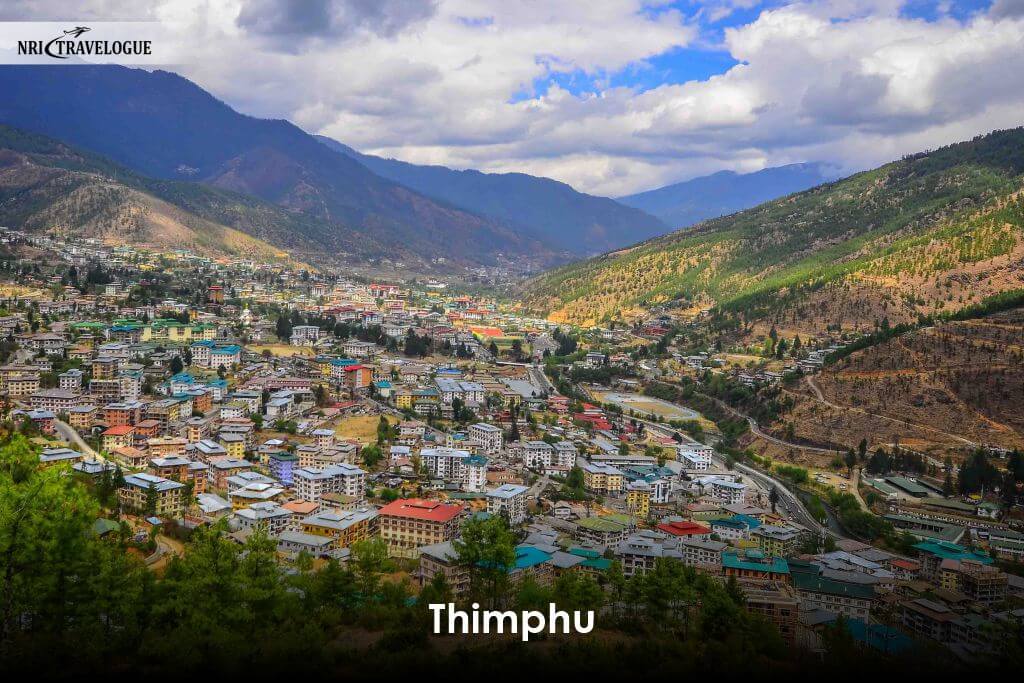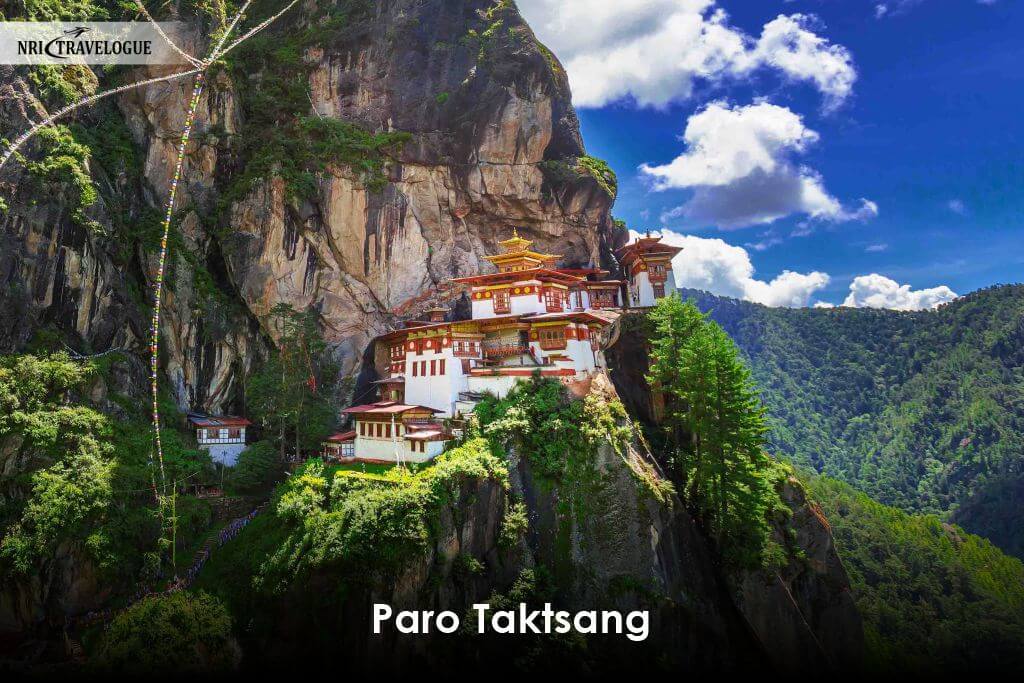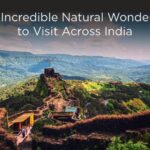Bhutan is popularly known as the “Land of the Thunder Dragon.” It is a tiny Himalayan hamlet that offers tourists an exceptional experience when it comes to peace, spirituality, and pristine natural beauty.
Nestled between China and India, Bhutan is a country that has protected its culture, traditions, and environment. It emphasizes well-being over material wealth and has led to the invention of the term, Gross National Happiness.
Bhutan showcases the towering peaks of the Himalayas, ancient Buddhist temples, eco-friendly tourism and adventure sports, which makes it an unforgettable experience for tourists. It attracts travelers with its festivals, vibrant arts, and culture.
The following is a list of the top 10 must-visit places in Bhutan, each offering unique experiences of this mystical kingdom.
Top Attractions in Bhutan
Team NRI has come up with a list of 10 must-see places in Bhutan. Scroll down to know more.
1. Punakha Dzong
Punakha Dzong, also known as “The Palace of Great Happiness,” is a fortress located at the meeting place of the Pho Chhu and Mo Chhu rivers. Build in the late 1630s, this grand structure is a landmark in Bhutan’s history. It was the seat of government until the mid-20th century. Now it is an important religious and administrative center.

The dzong is a popular tourist attraction in Bhutan with wooden carvings, golden roofs, and a scenic setting. Things to Do:
- Explore the dzong complex and its courtyards.
- Visit the Temple of the Divine Madman nearby.
- Participate in a prayer ceremony with monks.
- Admire the colorful murals and historical paintings inside the dzong.
- Walk along the riverside and across the scenic bridge.
2. Thimphu
Thimphu is the capital city and is a blend of modernism and traditional Bhutanese culture. It is the largest city and home to numerous cultural sites, including monasteries, fortresses, and museums.

The Buddha Dordenma, a vast statue overlooking the city, is a must-visit site in Thimphu. The Tashichho Dzong, the seat of Bhutan’s government and its king, also provides a deep insight into Bhutan’s religious and political history. For a peek into the Bhutanese culture, a visit to the National Textile Museum and the Folk Heritage Museum is a must.
Things to Do:
- Visit the Buddha Dordenma, a massive statue.
- Walk along the Tashichho Dzong and its manicured gardens.
- Know more about Bhutan’s weaving traditions at the National Textile Museum.
- Stroll through the Centenary Farmers’ Market for local produce and handicrafts.
3. Paro Taktsang (Tiger’s Nest Monastery)
Located on a cliff at an elevation of approximately 3,125 meters, Paro Taktsang is Bhutan’s most sacred place. Also known as Tiger’s Nest Monastery, it is believed that the revered Guru Rinpoche flew to this location on the back of a tigress and did meditation in a cave there.

To reach this pious place, tourists need to do a challenging hike. The trail goes through pine forests and one can witness prayer flags fluttering.
Things to Do:
- Trek to the monastery for scenic views of Paro Valley.
- Explore the sacred caves where Rinpoche meditated.
- Visit the monastery’s inner sanctum.
- Capture scenic photographs.
- Enjoy a traditional Bhutanese meal as you trek.
4. Bumthang Valley
Bumthang Valley is home to some of Bhutan’s oldest temples and monasteries, including Jambay Lhakhang and Kurjey Lhakhang. The valley is circled by dense forests and scenic villages.

Bumthang is also famous for its festivals, particularly the Jambay Lhakhang Drup. It witnesses sacred masked dances and rituals. The valley is a must-visit destination for those seeking to understand Bhutanese culture.
Things to Do:
- Visit one of the oldest temples in Bhutan, Jambay Lhakhang.
- Trek to Kurjey Lhakhang, where the body of Guru Rinpoche is preserved.
- Experience the joyous Jambay Lhakhang Drup festival.
- Taste the local Bumthang cheese and honey.
5. Haa Valley
If you want to witness unspoiled nature and traditional Bhutanese culture, Haa Valley is one of Bhutan’s most isolated regions. The valley has centuries-old temples and idyllic villages.

It is also home to two important religious sites in Bhutanese history, the Lhakhang Karpo (White Temple) and Lhakhang Nagpo (Black Temple). Haa Valley has lovely hills and verdant forests, so it a popular destination for trekkers.
Things to Do:
- Explore Lhakhang Karpo and Lhakhang Nagpo to understand Bhutan’s mythology.
- Hike through the beautiful Haa Valley for idyllic views.
- Visit local villages and experience traditional life in Bhutan.
- Go on a cycle tour and enjoy a picnic at the panoramic place.
6. Phobjikha Valley (Gangtey Valley)
Phobjikha Valley, also known as Gangtey Valley, is located in central Bhutan. It is known for its natural beauty as it is the winter home of the rare black-necked cranes. This serene valley is surrounded by scenic hills.

At the middle of the valley lies the Gangtey Monastery, one of the most important Nyingma monasteries in Bhutan. The valley is perfect for walking tours, where tourists can explore its untamed beauty and local villages.
Things to Do:
- Visit the Gangtey Monastery for a spiritual retreat.
- Experience the Gangtey Nature Trail for scenic views and wildlife.
- Look at the black-necked cranes.
- Explore local villages and interact with the locals.
7. Dochula Pass
Dochula Pass is located at an altitude of around 3,150 meters. It offers breathtaking views of the snowy Himalayas. The pass is home to 108 stupas, built in memory of Bhutanese soldiers who lost their lives in armed conflicts.

Dochula Pass has spiritual and historical significance but its serene and scenic beauty make it a perfect tourist spot for relaxation.
Things to Do:
- Visit the Druk Wangyal Chortens and admire the stupas.
- Capture scenic photographs of the Himalayan peaks.
- Enjoy a traditional Bhutanese tea at the Café.
- Take a short nature walk around the pass.
- Enjoy the annual Dochula Druk Wangyel Festival, celebrated in December.
8. Chimi Lhakhang (Temple of Fertility)
Chimi Lhakhang, is a scenic monastery located near Punakha. Dedicated to Lama Drukpa Kunley, the temple’s association with fertility makes it popular among couples from around the world to seek blessings.

The temple is located amidst rice fields and traditional Bhutanese homes, which makes the journey to Chimi Lhakhang a must-visit place. Tourists can also explore the temple’s colourful murals, which depict Drukpa Kunley’s eccentric exploits.
Things to Do:
- Admire the vibrant murals and artwork depicting the life of Lama Drukpa Kunley.
- Enjoy a stroll through the surrounding rice fields.
- Visit the nearby villages and interact with locals.
- Participate in a traditional prayer session.
9. Chele La Pass
Chele La Pass, at around 3,989 meters, is the highest motorable pass in Bhutan. It offers stunning views of the Paro and Haa valleys. If the sky is clear, visitors can also see the sacred mountain Jomolhari, one of the most beautiful peaks in Bhutan.

The pass is adorned with colorful prayer flags, and is a favorite among trekkers and nature lovers. The pass also connects Paro and the remote Haa Valley, making it a perfect stop for tourists. The stunning views and peaceful vibes make Chele La Pass a must-visit destination.
Things to Do:
- Enjoy the breathtaking views of the scenic pass.
- Go on a short hike to explore panoramic views.
- Click the beauty of Mount Jomolhari and enjoy a picnic.
- Look around for the local flora and fauna, including blue pine trees.
10. Tashichho Dzong (Thimphu)
Located in Thimpu, Tashichho Dzong, is an impressive fortress that serves as the seat of Bhutan’s government. Originally built in the 17th century and later renovated over the years, today, it houses both the throne of the king and the summer residence of the monarch.

The architecture is a beautiful blend of traditional Bhutanese design and modern thought. Visitors are often in awe of the grandeur of its buildings, temples, and assembly halls. During the annual Thimphu Tshechu festival, Tashichho Dzong becomes a vibrant hub of religious and cultural activity.
Things to Do:
- Explore the beautiful interior of the dzong and stroll through the dzong’s gardens and courtyards.
- Attend the Thimphu Tshechu festival, held annually.
- Learn about Bhutan’s history from local guides.
- Visit the nearby National Memorial Chorten, a landmark in Thimphu.
Final Thoughts
Bhutan’s irresistible charm lies in its blend of spirituality, untamed natural beauty, and rich cultural heritage. Whether it’s the sacred allure of Paro Taktsang, the historical significance of Punakha Dzong, or the tranquil landscapes of Phobjikha Valley, Bhutan offers experiences that are both rejuvenating and enlightening. A trip to Bhutan is not just a journey to a new place but a journey within.
Yes, all international travelers (except Indian nationals) require a visa to enter Bhutan.
The best times are spring (March-May) and autumn (September-November) when the weather is pleasant and many festivals are celebrated.
No, Bhutan has a policy of “high value, low impact” tourism, which requires visitors to pay a daily fee that covers accommodation, food, and a guide, making it relatively expensive.
Thimpu, Paro Taktsang, Punakha Dzong, the tranquil landscapes of Phobjikha Valley are some of the best places to visit in Bhutan.
Yes, Bhutan offers numerous trekking routes, such as the Druk Path Trek, Jomolhari Trek, and Snowman Trek, catering to different levels of difficulty.









